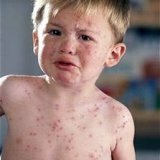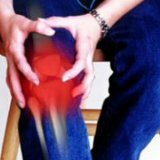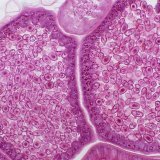Rubella: an infectious disease
 Rubella is an infectious disease that is characterized by intoxication, although in general it is a mild symptom. A mild rash on the body, enlarged lymph nodes( occipital and cervical) - all this refers to the symptoms.
Rubella is an infectious disease that is characterized by intoxication, although in general it is a mild symptom. A mild rash on the body, enlarged lymph nodes( occipital and cervical) - all this refers to the symptoms.
Reasons.
Various viruses, unstable in the environment, dying under the action of ultraviolet can become the causes of such a disease.
The source of the infection is a person with rubella, both of severe form and weakly expressed. Within a week after the rash, the virus begins to be released into the environment. Infection occurs, respectively, by airborne droplets.
That's why, with such a disease, doctors "plant" the society in which a person is in quarantine, and it is better to isolate a person from any physical connections with the public. Rubella during pregnancy.
The process of the development of the disease consists in the penetration of the virus into the mucous membrane of the respiratory tract of the body, then it is carried by blood.
For pregnant women, this rubella disease is especially dangerous. The virus enters the fetus and its growth slows down. In addition, deformities of varying degrees can be formed. Rubella disease in the third week of pregnancy leads to such consequences in 60% of cases, on the thirteenth week - in 7%.
How is this disease?
After a person tolerates such a disease, there is a persistent immunity to viruses for life.
The period of the disease lasts from 10 to 25 days. The signs are sharp. Lymph nodes increase, physical weakness, malaise, headache, fever( up to 38 degrees).Together with this, a rash appears on the face in the form of specks of pale pink shade. In addition, dry cough, dryness in the throat, runny nose may appear. Elevated temperature will be several days( two to three days), enlarged lymph nodes - a few days longer. It happens that rubella manifests itself as a slight fever of the body without the appearance of a rash.
In any case, you can diagnose the diagnosis only by researching blood specialists, that is, you need to pass a blood test. Pull with such a diagnosis is not worth it. If you notice any symptoms, contact your doctor right away.
Complications.
The complication of rubella is usually expressed in the form of arthritis. In adults this is the most common phenomenon, than in children. Infectious disease is accompanied by the following symptoms: swelling and soreness of the joints may appear a couple of days after the disappearance of the rash and stay for six to ten days.
Treatment.
Rubella is administered at home. If the child is sick, he needs a bed rest, proper nutrition and abundant drinking. In addition, sometimes symptomatic agents are used in treatment. If complications do appear, hospitalization is necessary.
There is also a good prognosis - repeated infection with rubella is impossible. In any case, with the transfer of such a disease, the body's immunity will not allow a second disease. Therefore, the child, having had rubella, can not be afraid to get infected with it at an older age.
There are rare cases when a second infection occurs after a childhood illness or after a vaccination. Re-infection during pregnancy does not have such negative consequences for the fetus, however, the appearance of rash and developing antibodies, after two weeks, cause discomfort. Passive immunity, which can be purchased in such cases, in the form of maternal antibodies will provide protection against the virus for several months. In addition, immunity can affect the very formation of an immune response to rubella vaccination.
How to protect yourself from rubella?
How to prevent yourself from this infection, because this is an infectious disease, and few want it to suffer. To prevent the virus from spreading, it is necessary to isolate the unrepentant children within 5 days of the rash. Especially strictly it is necessary to watch, that there was no contact of the patient with pregnant women, as a rubella can lead to sad consequences and to do much harm to a fetus.
Vaccination.
The vaccination schedule includes vaccination of rubella. It is administered subcutaneously or intramuscularly for 12-14 months for 6 more years. Immunity develops in two weeks and persists for 20 years or more.
It is worth remembering that there are some contraindications to vaccination against rubella. Such are immunodeficiency states, allergies and personal intolerance, as well as pregnancy. Vaccinations are carried out at the end of the disease or at the end of an exacerbation of a chronic disease. In no case can not be vaccinated during any serious illness.
Vaccination is also intended for the adult population, especially those who have the most frequent contact with children. For example, employees of preschool, primary school, maternity or infectious departments. When vaccinating women, doctors must warn that it is necessary to avoid pregnancy within three months. The onset of pregnancy during this period, requires its interruption, since no case of fetal pathology has been registered in such conditions. Vaccination against rubella is not an indication for abortion. Breastfeeding is also not a contraindication to vaccination.
Observation of an anaphylactic reaction to neomycin or a negative, aggressive reaction of the body to a previous dose of rubella vaccine leads us to the conclusion that persons with such consequences should not be vaccinated.
In addition, people with high immunodeficiency, including those with congenital immune disorders, should also not be vaccinated. However, HIV-positive individuals can be vaccinated if there are no clinical signs.
Before you start treatment, make sure you are dealing with rubella, and not with such viruses, similar symptoms - allergic reaction, chickenpox, measles. If the child( and carriers are usually children) is really sick with rubella, then the treatment should be reduced to the use of specialized drugs that are characteristic for the treatment of this particular disease, taking into account the characteristics of the child's body. It is advisable, as we have already said, that the child observe bed rest and take a lot of fluids, because this will contribute to his recovery.



